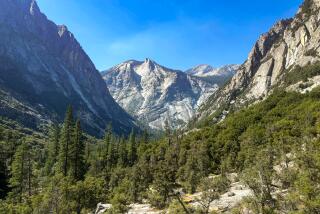Burns’ majestic history lesson
- Share via
For Californians, Ken Burns’ gorgeous and exhaustive six-part documentary on the National Parks poses something of a dilemma. In the 12 hours it takes for “The National Parks: America’s Best Idea” to unfold, an Angeleno could easily visit any of a half dozen national parks. Without traffic, you could conceivably get to Yosemite, where it all started, tour the valley floor and be back before narrator Peter Coyote stopped talking.
No doubt the various men behind the National Parks system, from mountain prophet John Muir to the touring-car-bound Franklin Delano Roosevelt would recommend you do just that. Indeed, the main goal of Burns and his co-creator Dayton Duncan appears to be launching people off their backsides and into the wilderness. In this they will most certainly succeed, possibly to the detriment of their own ratings.
Enlivened by astonishing camera work and a few dramatic adventures -- an early Yellowstone explorer becomes lost for more than a month, a tourist is later shot there during an Indian war, a young honeymoon couple vanishes from the Grand Canyon -- “The National Parks” is a slow and careful walk through a very specific branch of American history.
As much as one admires Burns’ refusal to acknowledge the conventional wisdom that the American attention span has shrunk to a hair’s breadth, there is no denying he could have picked up the pace a bit here. (Also, fiddle and banjo music should be banned from documentary usage for the next five years.)
The title is the first red flag. Yes, the “best idea” part comes from novelist and historian Wallace Stegner and one hates to argue with Stegner, but as historian Clay Jenkinson says within minutes of the film’s opening, America’s best idea is equal rights for every citizen. But “America’s Second-Best Idea” doesn’t have the same ring, does it?
So Burns and Duncan content themselves with hammering home the idea that the parks are living symbols of democracy. And if you don’t believe them, well, here’s a bunch more people who think so too.
Although descriptive chronicles of early visitors to Yosemite and Yellowstone and the Grand Canyon are fascinating to hear (and if you are an American actor who was not asked to give voice to one, consider yourself snubbed), the ongoing testimony to the beauty and importance of nature becomes more than a little repetitive and unnecessary. In this case, a picture really is worth a thousand words, and possibly two whole hours.
The history of the national park crisscrosses the history of America and is therefore a bittersweet narrative. America comes into being at the expense of its natives, from the Indian tribes forced out of their homelands, including Yosemite Valley, to the carrier pigeon hunted into extinction.
The real value of “National Parks” is not its reminder of how beautiful the Grand Canyon is but Burns’ and Duncan’s endless curiosity about how the parks shaped Americans as Americans shaped the parks.
Coming at a time when the role and size of the federal government is the subject of vitriolic debate, it’s difficult not to see in the film a rousing vote of confidence for big government.
Here, the parks are presented not just as places of beauty and refuge but as the soul-saving antidote to the ruthless nature of capitalism and American ambition. Which is certainly true.
Yet, as we quickly discover, their existence is due almost entirely to the personal desires and relentless life’s work of a handful of men, many of them major capitalists. Most of the parks owe at least some of their acreage to the checkbooks of wealthy men (making them monuments to noblesse oblige as much as anything else). Meanwhile, President Theodore Roosevelt, brandishing the new and vaguely worded Antiquities Act, created a slew of National Monuments, a process that didn’t require Congressional approval. So like the U.S., the parks are more complicated than patriotic catch-phrases would have them.
It is the narrative of those extraordinary men that moves “The National Parks” forward. From the early days of nature-loving Transcendentalism to the modern Green movement, strong-minded individuals determined that preserving certain lands was best for the country and they spent their lives pursuing that goal.
Muir personally swayed presidents, early newspaper accounts brought thousands of people on difficult journeys to see Bridal Veil falls and the Yellowstone Valley, stories in Field and Stream brought about protective legislation, John D. Rockefeller gave us Jackson Hole and much of the Tetons.
So “The National Parks” does chronicle a loss: the ethos of rugged individualism, the influence of a single dedicated voice. Now it seems too easy for voices like Muir’s or Park Service founder Stephen Mather’s to be lost in the cacophony of information, opinion and invective. Burns stands with the zealous subjects of the film. Like Muir, he is unwilling to bend to public taste. Yes, here are those darn fiddles and the headshot interviews, here are the letters and journals read by Tom Hanks and John Lithgow, here are all those photographs and more information about the National Parks than you’ll ever be able to retain.
But his message from one documentary to another remains the same: Pay attention, take notes, listen to the people who were there at the time, because despite what you may have been taught, history is a gorgeously complicated thing.
--
--
‘The National Parks: America’s Best Idea’
Where: KCET
When: 1 and 8 p.m. Sunday, continuing at 8 p.m. Monday through Friday
Rating: TV-G (suitable for all ages)
More to Read
Sign up for The Wild
We’ll help you find the best places to hike, bike and run, as well as the perfect silent spots for meditation and yoga.
You may occasionally receive promotional content from the Los Angeles Times.







